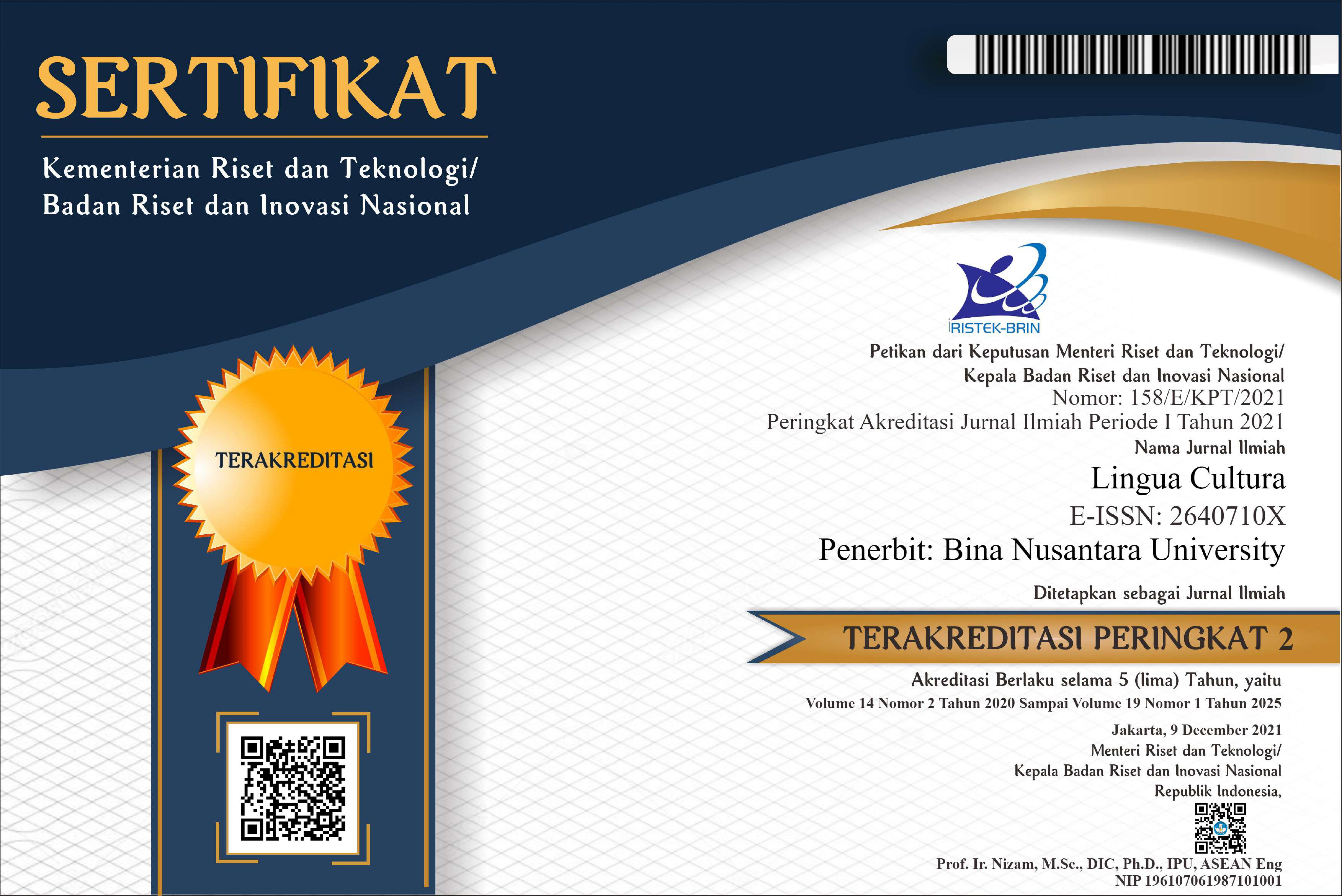PARMI (Production, Attention, Retention, Motivation, and Innovation): An alternative to improving scientific writing skills
DOI:
https://doi.org/10.21512/lc.v12i4.4159Keywords:
PARMI, scientific writing, writing skillsAbstract
This research aimed to describe the development of scientific writing model based on PARMI. The stages included: creating prototypes; and developing models through four stages, focus group discussions, experts’ considerations, limited trials, and extensive trials. The research involved students and lecturers from STAIB (Islamic Bunga Bangsa Institute), STAIC (Islamic Institute of Cirebon), STAIMA (Islamic Institute of Ma’had Ali), and ISIF (Fahmina Institute of Islamic Studies) between July and December 2014. In these model included a philosophical foundation, either a concept or a principal; its application; and its effects. It finds that based on expert judgment, this model is feasible to be developed and piloted. The results of the limited trials provide some improvement, especially on the application of PARMI. Based on the results of extensive trials it can be concluded that PARMI can improve students’ ability in scientific writing.
Plum Analytics
References
Alemi, M., & Daftarifard, P. (2010). Pedagogical innovations in language teaching methodologies. Journal of Language Teaching and Research, 1(6), 765–770. https://doi.org/10.4304/jltr.1.6.765-770.
Bair, M. A., & Mader, C. E. (2013). Academic writing at the graduate level: Improving the curriculum through Faculty collaboration. Journal of University Teaching & Learning Practice, 10(1), 1-14. Retrieved from http://ro.uow.edu.au/jutlphttp://ro.uow.edu.au/jutlp/vol10/iss1/4.
Bandura, A. (1989). Social cognitive theory. In Handbook of Social Psychological Theories (Vol. 6, pp. 1–60). Greenwich: JAI Press. https://doi.org/10.1037/13273-005.
Bandura, A., & Cervone, D. (1986). Differential engagement of self-reactive influences in cognitive motivation. Organizational Behavior and Human Decision Processes, 38(1), 92–113. https://doi.org/10.1016/0749-5978(86)90028-2.
Denler, H., Wolters, C., & Benzon, M. (2009). Social Cognitive Theory. Retrieved from https://project542.weebly.com/uploads/1/7/1/0/17108470/social_cognitive_theory__education.com.pdf.
Direktorat Jenderal Pendidikan Tinggi. (2012). Surat Edaran Nomor 152/E/T/2012. Jakarta: Direktorat Jenderal Pendidikan Tinggi.
Giridharan, B., & Robson, A. (2011). Identifying gaps in academic writing of ESL students. Enhancing Learning: Teaching & Learning International Conference. Sarawak, Malaysia. pp 1–15. Retrieved from http://hdl.handle.net/20.500.11937/11979
Hasegawa, H. (2013). Students’ perceptions and performances in academic essay writing in higher education. International Journal of Innovative Interdisciplinary Research, 1(4), 1–14.
Kalidjernih, F. (2011). Penulisan akademik. Bandung: Widya Aksara Press.
Kellogg, R. T. (2008). Training writing skills: A cognitive developmental perspective. Journal of Writing Research, 1(1), 1–26. https://doi.org/10.17239/jowr-2008.01.01.1.
Lo, J., & Hyland, F. (2007). Enhancing students’ engagement and motivation in writing: The case of primary students in Hong Kong. Journal of Second Language Writing, 16(4), 219–237. https://doi.org/10.1016/j.jslw.2007.06.002.
Lucas, R., Pulido, D., Miraflores, E., & Ignacio, A. (2010). A study on the intrinsic motivation factors in second language learning among selected freshman students. Philippine ESL Journal, 4(February), 3–23. Retrieved from http://scholar.google.com/scholar?hl=en&btnG=Search&q=intitle:A+Study+on+the+Intrinsic+Motivation+Factors+in+Second+Language+Learning+Among+Selected+Freshman+Students#0.
Mahadi, T. S. T., & Jafari, S. M. (2012). Motivation, its types, and its impacts in language learning. International Journal of Business and Social Science, 3(24), 230–235. Retrieved from http://ijbssnet.com/journals/Vol_3_No_24_Special_Issue_December_2012/24.pdf.
Munandar, U. (2011). Pengembangan kreativitas anak berbakat. Jakarta: Rineka Cipta.
Muqowim. (2011). Pengembangan buku ajar MPK bahasa Indonesia berbasis integrated approach. Yogyakarta.
Nilsen, H. (2009). Influence on student academic behaviour through motivation, self-efficacy and value-expectation: An action research project to improve learning. Issues in Informing Science and Information Technology, 6(1), 545–556. Retrieved from http://www.ncbi.nlm.nih.gov/entrez/query.fcgi?cmd=Retrieve&db=PubMed&dopt=Citation&list_uids=15701243.
Sada, A. N., & Maldonado, A. (2007). Research methods in education, sixth edition - by Louis Cohen, Lawrence Manion, and Keith Morrison. British Journal of Educational Studies, 55(4), 469-470. Retrieved from http://www.tandfonline.com/doi/abs/10.1111/j.1467-8527.2007.00388_4.x.
Salkind, N. J. (2009). Teori-teori perkembangan manusia: Sejarah kemunculan, konsepsi dasar, analisis komparatif, dan aplikasi (Translated). Bandung: Nusa Media.
Sharples, M., Mcandrew, P., Weller, M., Ferguson, R., Fitzgerald, E., Hirst, T., Gaved, M. (2013). Innovating pedagogy policy makers. United Kingdom: The Open University. https://doi.org/10.2791/83258.
Sutrisno. (2012). Kreatif mengembangkan aktivitas pembelajaran berbasis TIK. Jakarta: Referensi.
Suyanto, B., & Sutinah. (2011). Metode penelitian sosial (1st Ed.). Jakarta: Kencana.
Downloads
Published
Issue
Section
License
Authors who publish with this journal agree to the following terms:
a. Authors retain copyright and grant the journal right of first publication with the work simultaneously licensed under a Creative Commons Attribution License - Share Alike that allows others to share the work with an acknowledgment of the work's authorship and initial publication in this journal.
b. Authors are able to enter into separate, additional contractual arrangements for the non-exclusive distribution of the journal's published version of the work (e.g., post it to an institutional repository or publish it in a book), with an acknowledgment of its initial publication in this journal.
c. Authors are permitted and encouraged to post their work online (e.g., in institutional repositories or on their website) prior to and during the submission process, as it can lead to productive exchanges, as well as earlier and greater citation of published work.
USER RIGHTS
All articles published Open Access will be immediately and permanently free for everyone to read and download. We are continuously working with our author communities to select the best choice of license options, currently being defined for this journal as follows: Creative Commons Attribution-Share Alike (CC BY-SA)

















